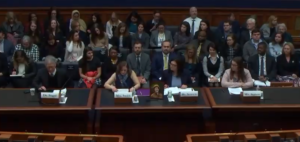Special Olympics Saved, but What About Other Disability Program Cuts in President’s Budget?
Washington, DC – It’s budget season in Washington, DC, and there’s a lot at stake in the proposals for people with intellectual and developmental disabilities (IDD). In the last few years, the Administration has consistently proposed cuts to programs that impact people with IDD and their families. From home and community-based services in Medicaid, to imposing work requirements, to a planned and then scrapped attempt to slash funding for Special Olympics, this year’s budget request, if Congress were to enact legislation reflecting the President’s priorities, would be harmful to the lives of people with IDD.
“If the Administration’s original budget request could cut $18 million from Special Olympics, which provides longstanding community benefit for thousands of people with disabilities, their families, and volunteers, then you should be asking yourself: what else is lurking in these proposals?
“Unfortunately, it’s the tip of the iceberg. The President’s budget proposes $2.7 trillion in cuts over 10 years. There are deep cuts to Medicaid on the table — the core program providing access to health care and home and community-based services for people with disabilities. The cuts come in the same form as those included in the 2017 proposals to repeal the Affordable Care Act (ACA) and cut and cap the Medicaid program. Congress rejected this in 2017, but the Administration proposed budget includes replacing both the Medicaid expansion and ACA subsidies with a block grant, and converting the rest of Medicaid into a per capita cap which would deeply cut the program and cap the amount of funding available. The end result of these proposals being put in place would be less money for states, restrictions on eligibility, cuts to services, and growing waiting lists.
“And once again, the budget proposes work requirements for Medicaid. Applying this policy would have devastating effects on health care coverage — particularly for people with complex health care needs, and likely many people with disabilities.
“What we invest in says a lot about our country and our values. We’ve come a long way in expanding disability rights and including people with disabilities in all aspects of the community, across the lifespan. We won’t go backwards and this budget request takes us in the wrong direction,” said Peter Berns, CEO, The Arc.
The Arc has compiled information about the Administration’s budget request as it pertains to programs that provide services and supports for people with IDD and their families.
The Arc advocates for and serves people with intellectual and developmental disabilities (IDD), including Down syndrome, autism, Fetal Alcohol Spectrum Disorders, cerebral palsy and other diagnoses. The Arc has a network of over 650 chapters across the country promoting and protecting the human rights of people with IDD and actively supporting their full inclusion and participation in the community throughout their lifetimes and without regard to diagnosis.
Editor’s Note: The Arc is not an acronym; always refer to us as The Arc, not The ARC and never ARC. The Arc should be considered as a title or a phrase.










